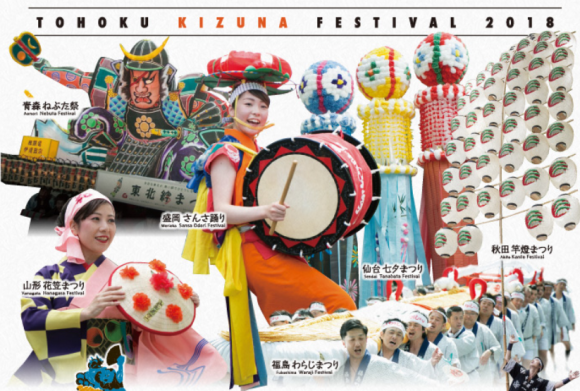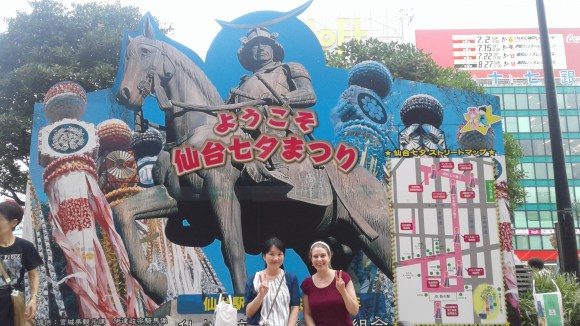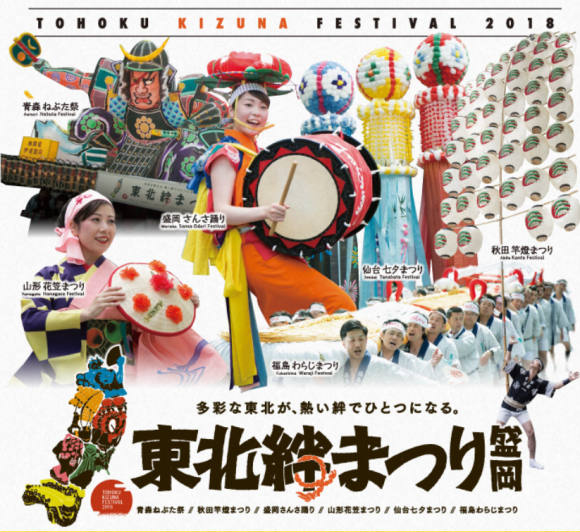
This “Festival of Tohoku Bonds” continues to pay homage to six of northern Japan’s most important annual festivals all at one time and one place.
The six northeastern prefectures that make up Japan’s main island of Honshu are an often overlooked choice for travel despite boasting some of the most pristine natural scenery and diverse cultural traditions in the entire country. The region did come into international focus under tragic circumstances in 2011, when one of the strongest earthquakes ever recorded struck off the east coast of Miyagi Prefecture and the resulting tsunami also created a nuclear disaster in neighboring Fukushima Prefecture. The people of Tohoku subsequently astounded the world with their undying spirit in spite of unbelievable destruction and loss throughout their home region.
One of the earliest responses of the Tohoku people to join together, lift each other’s spirits, and show support for recovery came in the form of the Tohoku Rokkonsai (“Tohoku Six Souls Festival”), which was first held in Sendai (Miyagi Prefecture) a mere four months following the disasters. This mega-festival showcased six of the major summer festivals celebrated annually throughout the region–Aomori’s Nebuta Matsuri, Akita’s Kanto Matsuri, Iwate’s Sansa Odori, Yamagata’s Hanagasa Matsuri, Miyagi’s Sendai Tanabata Matsuri, and Fukushima’s Waraji Matsuri–while rotating the sponsoring city each year until all six capital cities in Tohoku had played host.
▼ A welcome sign for the Sendai Tanabata Festival just outside of Sendai Station in August 2017

When the Tohoku Rokkonsai made its final stop in Aomori City in 2016, people realized they weren’t quite ready to let go of such an important tradition just yet. Thus, a spiritual successor was born: the Tohoku Kizuna Festival.
Kizuna means “bonds” in Japanese, a concept which reflects the festival’s mission of strengthening the bonds between people, aiding in continued reconstruction efforts, and demonstrating gratitude for all the support shown to Tohoku over the past seven years. The inaugural event was held in Sendai last year, and this year it’s Morioka (Iwate Prefecture)’s turn, an order which mirrors the original trajectory of the Tohoku Rokkonsai.
▼ This year’s festival logo. The illustration on the right side cleverly condenses the six festivals’ most important cultural artifacts into a map of the Tohoku region.
The 2018 festival will be held this coming weekend, June 2-3, centering on the Morioka Castle Site Park (also known as Iwate Park) at the following times:
Saturday, June 2: 10 am-7 pm (parade from 1:30-4 pm)
Sunday, June 3: 10 am-5 pm (parade from 12:30-3 pm)
As the centerpiece of the entire festival, the parade will commence in front of the Morioka City Hall and advance down the main road. This procession will highlight snippets of all six of the individual festivals, from the giant floats of Nebuta Matsuri to the synchronized dancing drummers of the host city’s Sansa Odori, in an essentially six-for-one amazing deal. For a refresher on the meaning and symbolism of the six individual festivals, please refer to this earlier piece.
Event organizers predict a total of 300,000 people to visit the festival over two days. Morioka is about two hours and ten minutes from Tokyo via bullet train, so it’s even possible to plan a day trip if you’re looking for something to do this weekend outside of the big city. The Tohoku Kizuna Festival is definitely one of the best ways to get a taste of local Japanese culture not able to be experienced in the capital region and to show your support for an amazingly strong base community of people.
Source: Tohoku Kizuna Matsuri (Japanese, English)
Featured image: Tohoku Kizuna Matsuri (edited by SoraNews24)
Insert images (unless noted): Tohoku Kizuna Matsuri



 Imoni-kai: A hidden, delicious cultural gem of northern Japan
Imoni-kai: A hidden, delicious cultural gem of northern Japan Eva tie-wearing Japanese minister resigns after saying “it’s a good thing the tsunami hit Tohoku”
Eva tie-wearing Japanese minister resigns after saying “it’s a good thing the tsunami hit Tohoku” Latest design for gorgeous stylized Japanese Coca-Cola cans spotlights Tohoku festivals
Latest design for gorgeous stylized Japanese Coca-Cola cans spotlights Tohoku festivals Domino’s Pizza is actually training reindeer for delivery in northern Japan
Domino’s Pizza is actually training reindeer for delivery in northern Japan Japanese KitKats now come in edamame milkshake flavour
Japanese KitKats now come in edamame milkshake flavour How to order snacks on a Shinkansen bullet train in Japan
How to order snacks on a Shinkansen bullet train in Japan Burger King Japan suddenly adds Dr. Pepper and Dr. Pepper floats to its menu nationwide
Burger King Japan suddenly adds Dr. Pepper and Dr. Pepper floats to its menu nationwide Demon Slayer: Kimetsu no Yaiba gets new roller coaster attractions and food at Universal Studios Japan
Demon Slayer: Kimetsu no Yaiba gets new roller coaster attractions and food at Universal Studios Japan Japan’s new difficult-to-drink-from beer glass protects your liver, but it’s a brutal experience
Japan’s new difficult-to-drink-from beer glass protects your liver, but it’s a brutal experience Hello, cosmetics! Clinique teams up with Hello Kitty this summer for first-time collaboration
Hello, cosmetics! Clinique teams up with Hello Kitty this summer for first-time collaboration Nintendo history you can feel – Super NES, N64, and GameCube controllers become capsule toys
Nintendo history you can feel – Super NES, N64, and GameCube controllers become capsule toys Studio Ghibli releases Ponyo donburi bowl to bring anime ramen to life
Studio Ghibli releases Ponyo donburi bowl to bring anime ramen to life A visit to the best UFO catcher arcade in the universe!
A visit to the best UFO catcher arcade in the universe! New samurai glasses are Japan’s latest weird must-have souvenir
New samurai glasses are Japan’s latest weird must-have souvenir New Japanese banknotes selling online for up to 40 times original value
New Japanese banknotes selling online for up to 40 times original value “The most Delicious Cup Noodle in history” – Japan’s French Cup Noodle wins our heart【Taste test】
“The most Delicious Cup Noodle in history” – Japan’s French Cup Noodle wins our heart【Taste test】 Starbucks releases a cute Frappuccino and Unicorn Cake…but not in Japan
Starbucks releases a cute Frappuccino and Unicorn Cake…but not in Japan Kyoto Tower mascot termination reveals dark side behind cute Japanese characters
Kyoto Tower mascot termination reveals dark side behind cute Japanese characters McDonald’s Japan’s Soft Twist Tower: A phantom ice cream only sold at select branches
McDonald’s Japan’s Soft Twist Tower: A phantom ice cream only sold at select branches Yabai Ramen: What makes this Japanese ramen so dangerous?
Yabai Ramen: What makes this Japanese ramen so dangerous? Finally! Nintendo Japan expands Switch 8-bit controller sales to everybody, Online member or not
Finally! Nintendo Japan expands Switch 8-bit controller sales to everybody, Online member or not Japanese government wants to build luxury resorts in all national parks for foreign tourists
Japanese government wants to build luxury resorts in all national parks for foreign tourists To combat declining birth rate, Japan to begin offering “Breeding Visas” to foreigners
To combat declining birth rate, Japan to begin offering “Breeding Visas” to foreigners 10 things you should buy at 7-Eleven in Japan
10 things you should buy at 7-Eleven in Japan Studio Ghibli releases anime heroine cosplay dresses that are super comfy to wear
Studio Ghibli releases anime heroine cosplay dresses that are super comfy to wear Woman charged for driving suitcase without a license in Osaka
Woman charged for driving suitcase without a license in Osaka Studio Ghibli unveils My Neighbour Totoro miniature house model
Studio Ghibli unveils My Neighbour Totoro miniature house model Kyoto experiencing problems with foreign tourists not paying for bus fares, but not on purpose
Kyoto experiencing problems with foreign tourists not paying for bus fares, but not on purpose Fighting mild hunger with a Japanese soda that turns into jelly in the stomach【Taste test】
Fighting mild hunger with a Japanese soda that turns into jelly in the stomach【Taste test】 Studio Ghibli’s Howl’s Moving Castle tapestry unveiled in Japan for first time
Studio Ghibli’s Howl’s Moving Castle tapestry unveiled in Japan for first time McDonald’s new Happy Meals offer up cute and practical Sanrio lifestyle goods
McDonald’s new Happy Meals offer up cute and practical Sanrio lifestyle goods Sales of Japan’s most convenient train ticket/shopping payment cards suspended indefinitely
Sales of Japan’s most convenient train ticket/shopping payment cards suspended indefinitely Sold-out Studio Ghibli desktop humidifiers are back so Totoro can help you through the dry season
Sold-out Studio Ghibli desktop humidifiers are back so Totoro can help you through the dry season Japanese government to make first change to romanization spelling rules since the 1950s
Japanese government to make first change to romanization spelling rules since the 1950s Foreigner’s request for help in Tokyo makes us sad for the state of society
Foreigner’s request for help in Tokyo makes us sad for the state of society Ghibli founders Toshio Suzuki and Hayao Miyazaki contribute to Japanese whisky Totoro label design
Ghibli founders Toshio Suzuki and Hayao Miyazaki contribute to Japanese whisky Totoro label design Doraemon found buried at sea as scene from 1993 anime becomes real life【Photos】
Doraemon found buried at sea as scene from 1993 anime becomes real life【Photos】 Tokyo’s most famous Starbucks is closed
Tokyo’s most famous Starbucks is closed Princesses, fruits, and blacksmiths: Study reveals the 30 most unusual family names in Japan
Princesses, fruits, and blacksmiths: Study reveals the 30 most unusual family names in Japan Zoo Jeans from Japan uses denim marked with the claws and teeth of lions
Zoo Jeans from Japan uses denim marked with the claws and teeth of lions The most crowded place in Tokyo? Might be the Kanda Matsuri festival, but it’s still awesome
The most crowded place in Tokyo? Might be the Kanda Matsuri festival, but it’s still awesome Coca-Cola’s new limited-edition Japan travel destination bottles highlight history and culture
Coca-Cola’s new limited-edition Japan travel destination bottles highlight history and culture Stylish black Shinkansen, decorated with fireworks, spotted on the rails of Japan 【Photos】
Stylish black Shinkansen, decorated with fireworks, spotted on the rails of Japan 【Photos】 Self-screening urine test for depression and other mental illness developed in Japan
Self-screening urine test for depression and other mental illness developed in Japan Aomori’s fabled Nebuta Festival 2015 to feature Star Wars floats
Aomori’s fabled Nebuta Festival 2015 to feature Star Wars floats The sweet smell of virtual YouTuber success – Kizuna Ai’s new fragrance on sale now
The sweet smell of virtual YouTuber success – Kizuna Ai’s new fragrance on sale now Don’t forget: Yahoo! Japan to make disaster relief donation for every person who searches for “3.11” today
Don’t forget: Yahoo! Japan to make disaster relief donation for every person who searches for “3.11” today Hot springs website reveals the most popular user-picked onsen in all of northern Japan
Hot springs website reveals the most popular user-picked onsen in all of northern Japan Shinto shrine naked festival ritual asks men to cover up for first time in three-century history
Shinto shrine naked festival ritual asks men to cover up for first time in three-century history Taste-testing Japan’s beef tongue/gacha beef vending machine in Sendai【Taste test】
Taste-testing Japan’s beef tongue/gacha beef vending machine in Sendai【Taste test】 Great East Japan Earthquake: Commemorate eight years and donate with a search on Yahoo! Japan
Great East Japan Earthquake: Commemorate eight years and donate with a search on Yahoo! Japan Online survey sheds light on prefectural personality rankings of Japanese people
Online survey sheds light on prefectural personality rankings of Japanese people New ultra-stylish, extra-traditional Shinkansen has tatami floors, foot baths
New ultra-stylish, extra-traditional Shinkansen has tatami floors, foot baths There’s more to do than just look at the flowers at Tokyo’s biggest riverside sakura celebration
There’s more to do than just look at the flowers at Tokyo’s biggest riverside sakura celebration
Leave a Reply